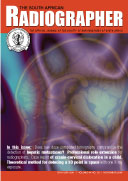Theoretical method for detecting a 3D point in space with one X-ray exposure
Keywords:
Stereoscope, horopter, pseudoscopic, point focus, finite focus, penumbraAbstract
Two x-ray exposures are normally done to detect the position of an artifact in space. This is achieved by either moving the X-ray tube or the patient to obtain a 90-degree view from the previous one. In the movement of the patient, the position of the artifact is moved from the anterior posterior (AP) to the lateral (Lat) position [1]. This technique results in dose to the patient. A method to detect the position in space with only one X-ray exposure was developed to limit the amount of radiation for detection of an artifact. This article discusses this technique as well as methods to improve image quality in terms of position detection is space [ 2-7].Downloads
Published
2007-01-30
Issue
Section
Original Articles
License
Copyright on all published material belongs to the Society of Radiographers of South Africa (SORSA).I hereby understand and declare that:
- All proprietary rights other than copyright are reserved to the authors, as well as the right to reproduce original figures and tables from this item in their future works, provided full credit is given to the original publication The South African Radiographer ISSN 0258 0241.
- In consideration of the reviewing and editing done by the editors of The South African Radiographer of the above named manuscript, the author/s hereby transfer, assign, or otherwise convey all copyright ownership world-wide, in all languages, to the Society of Radiographers of South Africa in the event that this manuscript is accepted for publication.
- If the manuscript has been commissioned by another person or organisation, or if it has been written as part of the duties of an employee, that full authorization has been given by the representative of the commissioning organisation or employer to be published in the The South African Radiographer.


